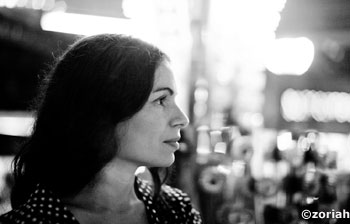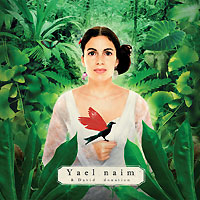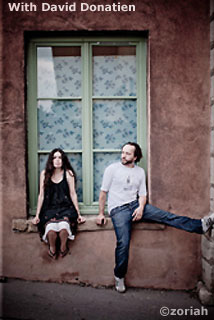Yael Naim’s inner world
Second album, She Was a Boy
Paris
16/11/2010 -
Three years after the huge media success of her first album, Yael Naim is back with a new opus, She Was a Boy. Accompanied once more by David Donatien, the Franco-Israeli singer tugs the same emotional chords, unearthing tenderness, passion and a complex inner search to overcome her fears and open out to the world.
RFI Musique: Your 2007 eponymous album was a great success, especially the track New Soul, which Apple used in their commercials. What did it change for you?
Yael Naim: My whole life! Before then, I had loads of time, I was on my own in my apartment and no one called me. Now I’m really busy. Let’s say that I used to drift along with my dreams, and now I’m confronted with a fairly appealing world that I’m connected to. In my work, there’s this phenomenon of the second album. They tell you that it’s going to happen, and then it does happen! And you put loads of pressure on yourself because you know that everyone’s going to compare it to the first one. After the tour, I spent three months with artist’s block: I felt as if everyone was in my sitting room listening to what I was composing. And people kept talking about deadlines and commercial presence, but that just froze me up. It’s in complete contradiction with the very idea of creation.

The previous album was about the passage into adulthood, with questions like, Where do I start? Who am I? When you’ve found your path, you take it further; you can move away from it, but you try to enrich it. I get the impression that a lot of things blossom from that root: the arrangements take off a bit more, the voice gets more intense. At the start, the kernel seems too precious and fragile and you don’t dare move away from it. On She Was a Boy I wanted to explore less trodden paths. I wanted to mix classical piano with other influences, like Nina Simone did. And then I wanted to take this mix of styles and roots further, right up to the Indian music in Man of Another Woman. I wanted to give it all shape, and go from very lyrical, arranged tracks to sparer, guitar-vocal numbers (Today, if I Lost the Best Thing). In total, I’ve got more than 200 songs under my belt now and I try to make it fun for David Donatien and myself. When I was twenty, I tried to write a record by thinking about others. It was a disaster! Now I just want to be happy. And if that shines through, then that’s great.
How do you work with your partner David Donatien?
I stopped touring for two years. There have been changes in our lives. We left our small apartment crammed with musical instruments and moved into a house outside Paris. We work all day. For a song to materialise, it has to appeal to both of us in its constant shuttling backwards and forwards. We arrange it, hone it, argue it out and argue with each other while we wait for the moment of truth! David and I are a group, even if the spotlight’s on me because they are my songs and my story. We work on everything 100% together: the composition, the concerts, the image.

I wanted it to be an extremely confident, clear-eyed photo, rather like an early photograph with its exaggerated poses. I also really like artists like Frida Kahlo. Her self-portraits contain some very strong symbolism representing her inner life. I don’t know why, but I imagined a forest, like a need to connect to my inner nature. At the same time, the nature is ambiguous because within this surreal abundance, carnivorous plants are hidden, and an elephant and two fish… The bird is strange too, all black with red wings. The artist is a war photographer called Zoriah Miller.
Why did you call the album She Was a Boy?
It’s the title of a song, and for some reason it struck me as an obvious choice, maybe it was my subconscious speaking. It tells the story of an unusual woman, with different proportions of shade and light and masculinity. She is misunderstood by everyone around her, except for one child pure enough to understand her. Then I realised that all of my songs are about that – about difference, and the gap between our desire to live and our terrors. This album carries with it a desire to stand back from our fears: fears of ourselves and of others, which are particularly rife in my country (Ed.: Israel). It’s a phenomenon that I think a lot about right now: it could all be so simple, we’re all the same, there are lots of fantastic cultures out there, and different tastes, and instead of enjoying this wide range, people close up and become rigid in their beliefs. Communities keep to themselves and don’t meet each other. And I’m one of the first to do so. If something happens to you, you defend yourself, you close in on yourself. Yet all that it would take is a bit of confidence and an innocent view of life.

What really helps in life, I think, is to learn to know yourself, believe in yourself and be flexible about change. It’s a process that I’m trying to put in place and it comes out in my songs. And with all the people around you, it’s easy to lose your identity; it’s very hard to stay tuned in to yourself and still be present for others. So you either stay shut in your own world, which is what I used to do, or you get caught up in the merry-go-round of life, like when you’re touring, and you can’t tune in to yourself anymore. Writing helps you get away from all that, even if it’s just a few minutes.
Your lyrics manage to be personal and universal at the same time.
If you can stay in tune with yourself, it’s actually easier to connect up to the outside world. I don’t think there’s any contradiction in that. When it comes down to it, we all experience similar emotions: fear, joy and the desire to make the most of ourselves. Every day.
Go to the river
Anne-Laure Lemancel
Translation : Anne-Marie Harper
11/10/2010 -
29/07/2010 -
25/06/2010 -
24/10/2008 -










